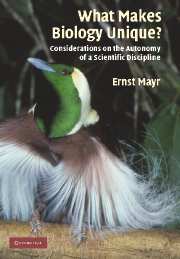Book contents
- Frontmatter
- Contents
- Preface
- Acknowledgments
- Introduction
- 1 Science and sciences
- 2 The autonomy of biology
- 3 Teleology
- 4 Analysis or reductionism?
- 5 Darwin's influence on modern thought
- 6 Darwin's five theories of evolution
- 7 Maturation of Darwinism
- 8 Selection
- 9 Do Thomas Kuhn's scientific revolutions take place?
- 10 Another look at the species problem
- 11 The origin of humans
- 12 Are we alone in this vast universe?
- Glossary
- Index
- References
3 - Teleology
Published online by Cambridge University Press: 10 December 2009
- Frontmatter
- Contents
- Preface
- Acknowledgments
- Introduction
- 1 Science and sciences
- 2 The autonomy of biology
- 3 Teleology
- 4 Analysis or reductionism?
- 5 Darwin's influence on modern thought
- 6 Darwin's five theories of evolution
- 7 Maturation of Darwinism
- 8 Selection
- 9 Do Thomas Kuhn's scientific revolutions take place?
- 10 Another look at the species problem
- 11 The origin of humans
- 12 Are we alone in this vast universe?
- Glossary
- Index
- References
Summary
Perhaps no other ideology has influenced biology more profoundly than teleological thinking (Mayr 1974, 1988, 1992). In one form or another it was a prevailing world view before Darwin. Appropriately, the discussion of teleology occupies considerable space (10–14%) in several recent philosophies of biology (Beckner 1959, Rosenberg 1985, Ruse 1973, Sattler 1986). This finalistic world view had many roots. It is reflected by the millenarian beliefs of many Christians, by the enthusiasm for progress promoted by the Enlightenment, by transformationist evolutionism, and by everybody's hope for a better future. Such a finalistic world view, however, was only one of several widely adopted Weltanschauungen.
Three concepts of the world
Grossly simplifying a far more complex picture, one could perhaps distinguish, in the period before Darwin, three ways of looking at the world:
A recently created and constant world. This was the orthodox Christian dogma, which, however, by 1859 had lost much of its credibility, at least among philosophers and scientists (Mayr 1982). This view has been revived in recent years by some fundamentalist Protestant sects.
An eternal and either constant or cycling world, exhibiting no constant direction or goal. Everything in such a world, as asserted by Democritus and his followers, is due to chance or necessity, with chance by far the more important factor. There is no room for teleology in this world view, everything being due to chance or causal mechanisms. It allows for change, but such change is not directional; it is not an evolution. This view gained some support during the scientific revolution and the Enlightenment, but it remained very much a minority view until the nineteenth century. A rather pronounced polarization developed from the seventeenth to the nineteenth centuries, between the strict mechanists, who explained everything purely in terms of movements and forces and who denied any validity whatsoever of the use of teleological language, and their opponents – deists, natural theologians, and vitalists – who all believed in teleology to a lesser or greater extent.
[…]
- Type
- Chapter
- Information
- What Makes Biology Unique?Considerations on the Autonomy of a Scientific Discipline, pp. 39 - 66Publisher: Cambridge University PressPrint publication year: 2004



